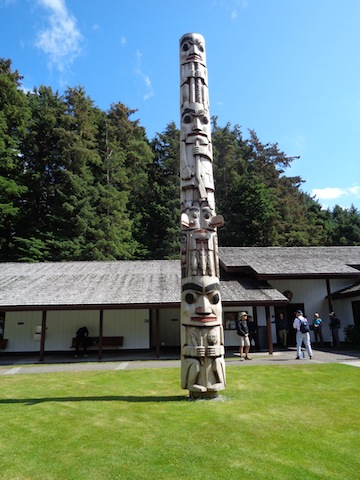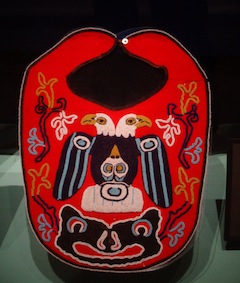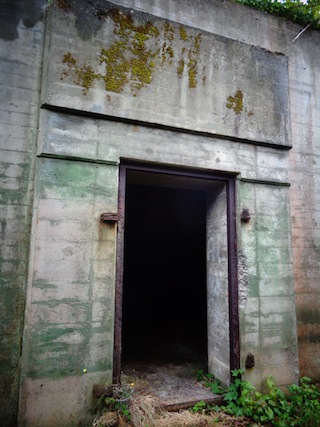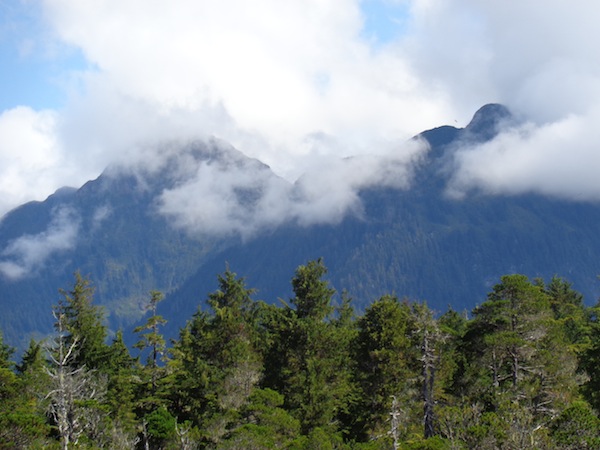The mountains of Sitka, Alaska. (photo by Deborah Rubin Fields)
“You have to look at Jews like Bina Gelbfish, to explain the wide range and persistence of the race. Jews who carry their homes in an old cowhide bag, on the back of a camel, in the bubble of air at the centre of their brains. Jews who land on their feet, hit the ground running, ride out the vicissitudes and make the best of what falls to hand, from Egypt to Babylon, from Minsk Gubernya to the district of Sitka.” (from Michael Chabon’s The Yiddish Policemen’s Union)
Unlike Bina Gelbfish, Lisa Busch is not a fictional character living in Sitka, Alaska. The executive director of the Sitka Sound Science Centre, she has lived in the city for 30 years. She and her husband have two daughters and are active in the local Jewish community. Busch described her congregation as laid-back.

The congregation functions out of people’s homes. It does not have its own building. What it lacks in a physical facility, however, it makes up for in creativity. “We share Shabbat and holidays,” said Busch. “When my kids were little, we had a tot Shabbat group of moms and kids and the kids did mitzvot, making challah for neighbours, etc.”
Also when her “kids were little, we put on a Purim play every year,” she said. “My family hosts a Passover seder every year and my husband makes homemade gefilte fish out of rock fish or halibut.”
Both of Busch’s daughters had bat mitzvah celebrations. They learned Hebrew via Skype and the family brought up a rabbi to oversee. Accordingly, the ceremonies were a mix of Jewish traditions and local ones.
Busch said Hebrew lessons are taught by whomever “we could find in town who was willing. For example, we have a Coast Guard air station and buoy tender here and, sometimes, someone was just in town for a few years and willing to pitch in with the teaching. Also, one of the more observant Jews here, David Voluck, spent time with my kids when they were older and met with them over Torah studies and Jewish ideas.”
Busch said, “I am so very appreciative of all the community members who helped educate our kids. I was raised a humanist Jew and, while I am confident in our Jewish values, there is always so much more to know, and having people around us who were willing to share what they know was so wonderful. I’m not sure I could have accessed those kinds of people or those kinds of lessons in a larger city.”
When asked who leads the congregation’s prayers and/or Torah reading, Busch said it’s the task of the person who suggests the event.
The Sitka Jewish community has contact with the congregations in Juneau and Anchorage. The city has had visiting rabbis from both places.
Nowadays, with her daughters grown up, Busch participates in Shabbat and holiday gatherings. What she likes best about her congregation is it casualness and flexibility.

The flexibility of the Jewish congregation is reflected in the town as a whole, as today’s Sitka honours diversity. While this was not always the case – especially during the period of Russian rule (1799-1867) and when Alaska was a United States territory (statehood was achieved in 1960) – the culture of the indigenous Tlingit people is now highly respected.
There are examples, though, of acceptance that hearken to the past. One of the more humourous incidents involves St. Peter’s by the Sea, a small Episcopal church that is more than 100 years old. Before it opened in 1899, Bishop Peter Trimble Rowe and his congregants decided to include a rose window in the construction of the sanctuary. They placed an order with a glass company located in the eastern United States. They waited many months for the window to arrive. When the window finally came, they found that, instead of the Christian symbol that had been ordered as the focal point, there was a six-pointed Star of David. Considering the time it took to manufacture the window and the window’s complex dimensions, they decided to keep it. The church’s website notes that the Star of David window reminds congregants that Christianity grew out of Judaism.

Jews apparently began to live in Alaska shortly after the United States purchased the territory from the Russian Empire. A small group of Jews opened up shops in Sitka and, in 1868, a year after the U.S. purchase, Emil Teichman sailed to the city on behalf of the London Fur Co. He wrote in his diary: “the traders, keepers of billiard saloons and dealers in spirits … were mostly of the Jewish race and carried on a more or less illicit trade with the soldiers and Indians, evaded customs and excise duties, and were liable to prosecution at any moment had the administration of the law not been so lax.” (A Journey to Alaska) Interestingly, one Friday night, by chance, he passed a warehouse where some 20 Jewish men were conducting Sabbath eve prayers. Teichman commented: “Jews everywhere, even in the most remote countries, practise their devotional exercises. I should scarcely have expected it in Sitka among a community which engaged in such very disreputable occupations.”
Surrounded by water, temperate rainforests, wildlife and mountains, Sitka (visitsitka.org) is a very pleasant, picturesque and friendly town. It is not hard to understand why Jews have chosen to make it their home.
Deborah Rubin Fields is an Israel-based features writer. She is also the author of Take a Peek Inside: A Child’s Guide to Radiology Exams, published in English, Hebrew and Arabic.
***
Historic decision
In 1938, Harold L. Ickes, U.S. secretary of the interior department visited various parts of Alaska. He wanted to see whether the Alaskan territory could be used as a resettlement sanctuary for persecuted German Jews. Ickes maintained much of Alaska was uninhabited and underdeveloped. He believed that mass Jewish resettlement could potentially strengthen security in a U.S. territory then deemed vulnerable to attack. He had interior undersecretary Harry A. Slattery write a report, The Problem of Alaskan Development. The proposal advocated for the relocation of incoming European refugees into four main parts of Alaska. Opposition came from both within the American Jewish community and from without. Ultimately, the proposal failed, as President Franklin Delano Roosevelt did not give it his backing. Knowing today what happened to European Jewry over the next seven years, this was indeed a sad decision. See Gerald S. Berman’s article, “Reaction to the Resettlement of World War II Refugees in Alaska,” Jewish Social Studies 44 (Summer- Autumn, 1982): 271-282.
– DRF

